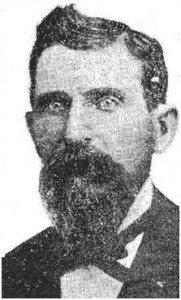The Road Began …
I became a District Superintendent in 2011. At DS “Charm School” they called those of us gathered there “Chief Missional Strategists” and gave us no further explanation or guidelines for becoming Missional Strategists. I have struggled ever since, seeking to find what is a Chief Missional Strategist and how does a DS become one. One of the ways I worked to find the answers was through my doctoral studies and through conversation with those who appoint DSs, the bishops. This project was designed to help those in this ministry position understand the full expectation of the Church for Chief Missional Strategists. This required that I go to the start of superintendency and move forward down the road to understand the history. So I began with the Presiding Elder.
This “happy,” “young,” and “eager looking” man was a Presiding Elder in The Methodist Episcopal Church. What began in the 1800’s as Presiding Elder has seen a progression and change beyond imagination. From riding to Quarterly Conferences and dedicating churches, to preaching commencement service and performing weddings for the rich, 1 the Presiding Elder had a full plate. Today, the Office of the District Superintendent looks very little like the Office of the Presiding Elder, with the exception that the person holding the office is still an ordained elder in the church. The ride has moved from horse to car. When one United Methodist says, District Superintendent or “DS”to another this meme is pretty typical of what runs through the minds of most in the United Methodist community.
The first curve in the road …
So, what is a District Superintendent? The definition is as varied as the Bishops who appoint them, but Chuck knows! In episode 52 of Chuck Knows Church, with some tongue in cheek humor and a lot of hidden truths, Chuck defines how different people view the role of a DS.
… or was that what it meant yesterday?
A hard left or right …
Since 2008 The United Methodist Church has been supporting the idea that District Superintendents are more than administrators and most definitely not the pastor to the pastors. The term Chief Missional Strategist was developed by the 2008 General Conference and was placed in The Book of Discipline of The United Methodist Church. While the title was there, little else was given to support the change or to offer direction as to what a Chief Missional Strategist was and how she or he served.
From the General Board of Higher Education and Ministry at http://www.gbhem.org/clergy/district-superintendents comes this definition. “The role of the district superintendent is best understood as ‘an extension of the office of the bishop.’ The district superintendent (DS) oversees the ministry of the clergy and the churches in the communities of the district, a task that requires pastoral leadership, personnel leadership, administration, and program leadership. The 2012 General Conference also made substantial changes to the ‘Specific Responsibilities of District Superintendents,’ highlighting the expectation that ‘the superintendent will be the chief missional strategist of the district.’” 2
While this is a great start it also creates several questions for me. What is a Chief Missional Strategist and how does it differ from a District Superintendent? Is the expectation that current District Superintendents will simply morph into Chief Missional Strategists? What leadership skills and what ministry gifts are needed for those who are to serve as Chief Missional Strategist? What about the care of the pastors? Have we forgotten them?
The Book of Discipline clearly states that the District Superintendent is chosen by the Bishop to serve an area of the annual conference called a District and to represent the office of bishop to the clergy and laity. How do bishops choose their superintendents? What criteria is used in deciding who is qualified to serve? Will the bishop appoint a Superintendent or a Chief Missional Strategist?
So many questions, so few answers. But today, 2016, the bishops seem to have a clearer understanding of what a Superintendent is and how they serve as the Chief Missional Strategist. For one bishop it begins with a depth of spirituality. Lest we forget, we are called to a holy office.
Bishop Carcaño reminds us that whatever title you use, there must be a depth of spirituality to the life and ministry of the one appointed to this office. While there are many tasks including administration, the foremost gift needed is a faith in Christ that can sustain.
Some of our bishops believe that District Superintendent and Chief Missional Strategist are two very different roles. The tasks of each office is too great for one person to do both with quality and success.
I have had many conversations with people who agree with Bishop Farr. They feel there is a need for a Chief Missional Strategist to cast a vision so that the church can be effective in the community. They also recognize the need for a DS to handle the administrative needs of the church and district. The two tasks are unique enough that to expect one person to do both would not be fair to both the conference or the person.
Here is a different opinion from Bishop Jonathan Holston of the South Carolina Annual Conference.
So Bishop Holston believes it is possible to combine the two roles. Relationships are key in being effective in this office. It will afford the District Superintendent/Strategist the ability to help the church be all it can be.
I agree, one cannot function as a leader, especially one that is being appointed to enact change and bring vitality, without the ability to create relationships. We must remember for all the business application of strategic thinking and planning, this is work about building relationships. The work that was begun by Jesus Christ.
Relationships alone will need a Chief Missional Strategist who can create and empower. The office of Superintendent needs to be focused and mindful of the bigger picture and changes that must be made to serve effectively in this day and time. Bishop Ken Carter, episcopal leader of the Florida area and one of the authors of the legislation that brought about the fuller understanding of the Chief Missional Strategist, shares some whys and how to’s for this new road the Superintendent must travel.
No longer pastor to pastors, no longer simply a supervisor, or even “just” an extension of the office of the Bishop, District Superintendents must adapt and change with the needs of the church and community. The road leads to a new way of serving and guiding the church.
In my conference of North Georgia, there is a fresh wind blowing. We have received a new bishop as of last September 2016. She comes with clarity and insight to what this Missional Strategist should look like and how best to transition current leadership from Superintendent to Strategist as well as knowing what are the qualities of the Strategist that will best serve the church which is in a truly different day.
Bishop Sue Haupert-Johnson is clear that the role is different from yesterday and still begins with the work of Holy Spirit moving in the lives of all of God’s people. In looking for her first set of Superintendents, she has asked the North Georgia Annual Conference to nominate people who fit the role of Missional Strategist. Here is her list of requirements:
1. I will give due consideration to the inclusiveness of The United Methodist Church with respect to sex, race, national origin, physical challenge, and age.
2. I invite you to read over paragraphs 418-19 of The Book of Discipline and see who comes to mind as you consider these roles and duties of the superintendent.
3. The fruits of the Spirit (love, joy, peace, patience, gentleness, kindness, faithfulness, generosity, and self-control) should be evident in their lives for all to see.
4. They should live disciplined lives in the sense that they are true “Method-ists”: daily attending to the means of grace and living as mature disciples of Jesus Christ. I need people of prayer more intent on following the Holy Spirit than going their own way.
5. They should work and play well with others, promoting unity and building bridges. I want a team player who will work well with the Cabinet. I don’t mind strong personalities, but I cannot abide pettiness, meanness, and ugliness. Respect for others is essential, and I want folks who are widely respected throughout the annual conference.
6. High on my list: those who think strategically and see the big picture.
7. I would like folks who have been fruitful and effective in their previous appointments.
8. They need to be innovative, creative, and willing to envision Church in new ways, while keeping what is best and working now.
9. They need to be good listeners who pay attention. They need to communicate hope and be committed to creating a culture of joy.
10. They will need to be able to make difficult decisions and conduct difficult conversations. They will need to be courageous and not shrink from being agents of change.
11. They will need to be honest with me and tell me when I have a bad idea. 3
The road ahead ….
My friend, Sky McCracken, a fellow District Superintendent in the Memphis Conference talks about change too. He has lived the life of a DS and offers some great thoughts in his blog, “D.S. as the Chief Missional Strategist and Breaking the Rules … Revisited” He states,
Unless we want the Book of Discipline to continue to become larger and the UMC to continue to become smaller, we have to break the cycle – not just because we’re dying, not just because pastors won’t have a pension, but because we’re not making disciples for the transformation of the world – our mission! If we rely on the General Conference to make these bold changes, we will fail. We have to become bold ourselves, and transform into individuals who embrace and enable change.
So this D.S. is willing to break a few rules, not for the sake of going rogue, but for the sake of being faithful to the Kingdom. I don’t want to meet my Maker one day and be asked why I chose to be a Pharisee instead of bold leader and disciple-maker. There has to be a better way.” 4
Sky listed 5 things that would make a great Chief Missional Strategist. It is a great list that I have adapted for my understanding.
- Be in the local churches regularly and build relationships with the clergy
- Be willing to make the tough decisions and stand by them in the face of criticism.
- Be a part of the Bishop’s Team of Strategists working together for the Kingdom of God.
- Be willing to get in your car and drive, or put on your tennis shoes and walk to learn about the communities where the churches are located.
- Know yourself and use the gifts God has given you for the Office of a Missional Strategist.
The role of pastor to the pastors is over, and we are turning down a new road that will be where the Superintendent will offer the difficult but rewarding directions for a future life of the churches of her/his area. This will involve supervision that has the support of the bishops who are a part of the team and not kept at a safe distance. Superintending as Chief Missional Strategist still needs to be fleshed out in The Book of Discipline and still needs to be worked on until those new coming on have a clear handle and can function with the gifts and tools needed. Therefore, I will be presenting a resolution to the 2020 General Conference of The United Methodist Church for adoption that will give clear and concise qualification and direction for the Chief Missional Strategist.
In 2011, when I became a DS, I brought a definition with me. There have been changes in this role since that first day. I hope my mind is “cracking open” to the new possibilities and that I can make the switch from the superintendent to a full blown strategist. Should I not make the switch, I do believe most of the things I have learned can be used in the local church parish or other appointment. It is important that those with the qualities that match the definition of Chief Missional Strategist be chosen to serve as Superintendent/Strategist or District Strategist (DS). This is the way the church will be served and kept vital for the current day; it is the only way we will be able to help clergy and congregations make disciples of Jesus Christ for the transformation of the world.
- Paul Whitehead, The Recreations of a Presiding Elder… (Nashville, TN: Southern Methodist Publishing House, 1885), 7.
- General Board of Higher Education and Ministry, “District Superintendents,” accessed November 2016, http://www.gbhem.org/clergy/district-superintendents.
- Sue Haupert-Johnson, “From Bishop Sue: Input on District Superintendent Selection,” November 17, 2016 (3:18 pm EST) North Georgia Conference Communications, accessed November 17, 2016.
- Sky McCracken, “Kyrie Eleison – Pastoral thoughts and musings,” accessed November 2015. htttp://revdsky.blogspot.com/search?updated-min=2014-01-01Too:00:00-06:00&updated-max=2015-01-01Too:oo:oo-06:00&max-rsults=15
Save



